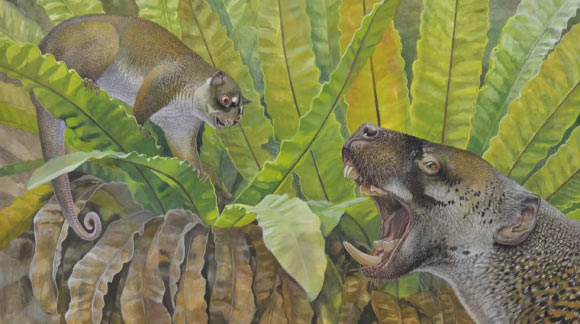A new species of ektopodontid possum has been described from Oligocene-age fossils found in central Australia.

Life reconstruction of Ektopodon serratus (top left), a relative of Chunia pledgei, and the marsupial lion Wakaleo oldfieldi (right). Image credit: Peter Schouten / CC BY-SA.
Chunia pledgei roamed our planet during the Oligocene epoch, some 25 million years ago.
It belongs to Ektopodontidae, an enigmatic group of marsupials known from the Late Oligocene to the Early Pleistocene of Australia.
These animals had short faces, large, forward-facing eyes and the most unusual and complex teeth of any marsupial.
“Chunia pledgei had teeth that would be a dentist’s nightmare, with lots of bladed points (cusps) positioned side by side, like lines on a barcode,” said Flinders University Ph.D. candidate Arthur Crichton and colleagues.
“This tooth shape is characteristic of species in the poorly known, extinct possum family Ektopodontidae.”
“The new species is unusual in that it has pyramid-shaped cusps on its front molars,” they added.
“These might have been useful for puncture-crushing hard foods — a bit like a nutcracker.”
“So what did ektopodontids eat? We don’t really know for sure — there’s no animal like them alive today anywhere in the world,” the paleontologists said.
“Based on aspects of their molar morphology, we infer they were probably eating fruits and seeds or nuts.”
“But they may have been doing something totally different!”
The fossilized remains of Chunia pledgei were found at the Pwerte Marnte Marnte fossil locality in central Australia.
According to the authors, the new species is likely the geologically oldest ektopodontid possum.
“Unfortunately, ektopodontids are tantalizingly rare in the fossil record, known only from isolated teeth and several partial jaws,” they said.
“The fossils show they had a lemur-like short face, with particularly large, forward-facing eyes.”
“But until we find more complete skeletal material, their ecology will likely remain mysterious.”
“What remains astonishing is just how little we know about the origins of Australia’s living animals, owing in no small part to a 30-million-year gap in the fossil record — half the time between now and the extinction of the dinosaurs.”
“At the same time, it’s inspiring to think about the countless strange and fascinating animals that must have once lived on this continent.”
“Fossil evidence of these creatures may still be sitting somewhere in the outback, waiting to be discovered.”
The findings were published online in the Journal of Vertebrate Paleontology.
_____
Arthur I. Crichton et al. A new ektopodontid possum (Diprotodontia, Ektopodontidae) from the Oligocene of central Australia, and its implications for phalangeroid interrelationships. Journal of Vertebrate Paleontology, published online February 23, 2023; doi: 10.1080/02724634.2023.2171299







